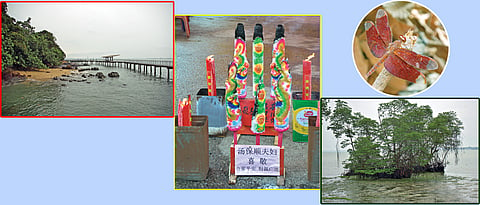

The hustle of modern cities exhausts me. Which is why I look for the road less travelled. Pulau Ubin or simply Ubin, a place with immense natural beauty in Singapore, perfectly fit the bill. There are no silvery beaches here but the charm of this offshore island makes it magical. This is a forested wetland teeming with wildlife and is also the place of the remaining ‘kampongs’ in Singapore. You can see glimpses of Singapore’s past as a trading hub and fishing port at Ubin, a place named after abandoned granite quarries.
To reach my destination, I headed straight for Changi Point Ferry Terminal from where I took a bumboat to Ubin located to the northeast of Singapore. After about 12 minutes, I spotted land and got ready to explore Pulau Ubin, a 10.2 sq km island that’s wildly different from Singapore with untamed jungle, glassy lakes and tin-roofed homes.
MANY MONIKERS
Pulau Ubin used to be mined for granite from the mid 1800s, and the name literally means Granite Island in Malay. Pulau means island, and Ubin is said to be a Javanese term for squared stone. To the Malays, the island is also known as Pulau Batu Ubin, or Granite Stone Island. The island is known as Tsioh Sua in Taiwanese, which means stone hill.
A LIVING MUSEUM
Ubin, the biodiversity hotspot, is home to over 700 species of plants, 30 species of mammals, 40 species of reptiles, 175 species of butterflies, 50 species of dragonflies and over 200 species of birds, and is home to the largest mangrove vegetation in the region.
A living museum may be a more accurate description for this impressive example of successful preservation of both Singapore’s heritage as well as the environment.
RUSTIC CHARM
From the jetty I headed straight for the village which was full of bicycle-rental outlets, cafes, small shops selling seasonal tropical fruits, coconuts and soft drinks, and the Fo Shan Ting Da Bo Gong Temple, which houses statues of local deities.
I quickly rented a bicycle and pedalled through rustic roads towards the Sensory Trail, going past a number of disused granite quarries, including the Pekan Quarry and traditional ‘kampongs’. The heat and humidity started taking a toll on me, as I found Pulau Ubin to be much larger than it appeared from the far shores of Singapore, but continued on to Chek Jawa and crossed several temples, shrines and also the night camping sites, Jelutong, Mamam Beach and Ubin Living Lab campsite.
I was visiting the island on a weekday and encountered only a few day-trip tourists cycling along with me, though I am sure the roads must be over-filled with tourists and cyclists on weekends.
CHEK JAWA WETLANDS
After hurriedly finishing my rendezvous with the island’s exotic flora and fauna I arrived at Chek Jawa Intertidal Wetlands, which was my ultimate aim — to explore the mangroves vegetation along with a variety of marine life such as sea hares, sea squirts, octopuses, starfishes, fishes, sponges, and cuttlefishes.
Some 5,000 years ago, Chek Jawa was a coral reef area and it still is virtually unspoilt. I was thrilled to be there standing on the natural rocky shore, enjoying sea water on my feet and the gorgeous sea views along with the mangrove swamp at the end of a boardwalk.
For exploring Chek Jawa, I first chose to walk on the 600m long Coastal Loop and around the wetland area; and then moved on to the 500m long Mangrove Loop; altogether 1.1 km of splendid views of the rustic island. The educational panels along the way helped me identify a few flora and fauna and learn a few fun facts. It was a low tide time when I was walking, and on the rocky shore and millennia-old coral rubble I spotted a lot of marine wildlife busy with their daily routine.
It is best to walk along the 1.1-km boardwalk during low tide to study and gaze down at life under water. Keep a lookout for sea critters such as mud lobsters, peacock anemone and the biscuit sea star.
I walked through the mangrove area to observe the plants and marine life at close range. I enjoyed observing the fiddler crabs as they scuttled along the shore and giving me the opportunity to shoot them with my camera. I was surrounded by Nipah palms, the only true mangrove palm found in such areas.
I was lost in nature. Time just flew as I kept moving amidst the mangroves and finally came to the Jejawi Tower, named after Malayan Banyan tree (Jejawi). The 20 m high tower looked impressive with a circular staircase and it was a breathtaking view from the top. I was above the tree canopy and hence the panoramic view of the island’s lush green cover, along the Johor River and all around, was amazing.
It was getting dark and I was very tired, so I made my way back to the jetty and got into the bumboat again to leave the island and head to the man-made modernity of the Lion City.
